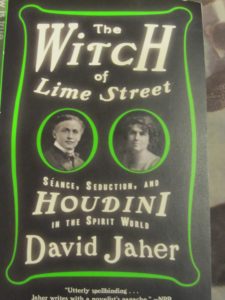Book Review: The Witch of Lime Street by David Jaher
In the wake of World War One, Spiritualism, a religious movement centering around contact with the dead, was on the rise. With this came a fad for mediums who claimed to be able to channel those unquiet spirits, both for the knowledge they had and to create uncanny physical effects. Understandably, there were many who were skeptical, but felt that these mediums should be scientifically investigated. Just in case there was any quantifiable evidence that wasn’t fake.
 Scientific American, the leading popular science magazine of that time, offered a cash prize to the first medium to pass rigorous scientific examination and be proved genuine. And on that five-man jury was one man who had a reputation for spotting fakes and chicanery–the magician and master escape artist Harry Houdini. Most candidates for the prize were easily disproven. But then there was Mina “Margery” Crandon, wife of a respectable Boston surgeon.
Scientific American, the leading popular science magazine of that time, offered a cash prize to the first medium to pass rigorous scientific examination and be proved genuine. And on that five-man jury was one man who had a reputation for spotting fakes and chicanery–the magician and master escape artist Harry Houdini. Most candidates for the prize were easily disproven. But then there was Mina “Margery” Crandon, wife of a respectable Boston surgeon.
Her gifts, brought to her through the spirit of her dead brother Walter, were impressive indeed. But was she the Queen of Mediums, or simply a master of parlor magic to rival the great Houdini himself? This is the story of their meeting and what came of it.
Told in bite-size chapters and a handful of photographs, this book starts with Arthur Conan Doyle learning of the end of WWI, and his involvement with the Spiritualists. His tours in support of the movement helped create interest in the United States, and indirectly led to the prize competition. He tried to recruit Houdini, but the showman was less than convinced. As became something of a pattern, Sir Arthur took Houdini’s politeness in not calling out a fake at the time as impressed belief.
We also learn of how Mrs. Crandon became a medium, but certain aspects of her and her husband’s earlier life are kept from the reader until much later in the story. (And some mysteries are never solved.) It should be noted that some conversations are reconstructed from later recollections, which may be fallible.
There’s a lot of interesting material in here for those interested in the mystic lore of the period, including a cameo by Theodore Roosevelt. But once the investigation of Margery begins, the chapters start to drag, and it feels like the author stretched this part to fill out the page count. Those of you who are history buffs will already have figured out that Mrs. Crandon didn’t win the magazine’s prize.
There’s a list of helpful sources for further reading, and an index. There’s quite a bit of discussion of female private parts, from whence mediums were supposed to issue ectoplasm (and, it was alleged, where fake mediums often hid props.) That might make the book unsuitable for readers below senior high level, depending on their parents’ discretion.
Overall, this is a helpful book for the reader who wants a quick look at Harry Houdini’s investigation of mediums from the aspect of his most famous case, and how it fit into events of the time. There are several fine biographies of Houdini that will be more helpful if his career is the reader’s primary interest.
Disclaimer: I received this volume from Blogging for Books for the purpose of writing this review. No other compensation was requested or offered.
